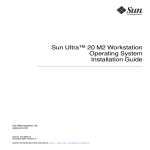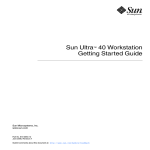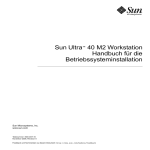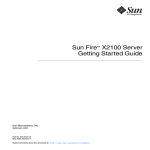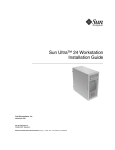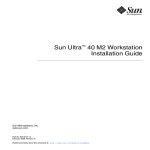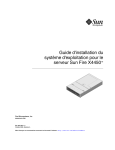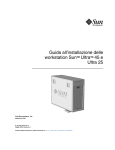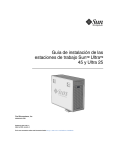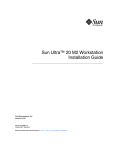Download Sun Ultra 40 M2 Workstation Operating System Installation Guide
Transcript
Sun Ultra™ 40 M2 Workstation Operating System Installation Guide Sun Microsystems, Inc. www.sun.com Part No. 819-7577-11 May 2007, Revision A Submit comments about this document at: http://www.sun.com/hwdocs/feedback Copyright 2006 -2007 Sun Microsystems, Inc., 4150 Network Circle, Santa Clara, California 95054, U.S.A. All rights reserved. Sun Microsystems, Inc. has intellectual property rights relating to technology that is described in this document. In particular, and without limitation, these intellectual property rights may include one or more of the U.S. patents listed at top://www.sun.com/patents and one or more additional patents or pending patent applications in the U.S. and in other countries. This document and the product to which it pertains are distributed under licenses restricting their use, copying, distribution, and decompilation. No part of the product or of this document may be reproduced in any form by any means without prior written authorization of Sun and its licensors, if any. Third-party software, including font technology, is copyrighted and licensed from Sun suppliers. Parts of the product may be derived from Berkeley BSD systems, licensed from the University of California. UNIX is a registered trademark in the U.S. and in other countries, exclusively licensed through X/Open Company, Ltd. Sun, Sun Microsystems, the Sun logo, AnswerBook2, docs.sun.com, Sun Ultra, Java, and Solaris are trademarks or registered trademarks of Sun Microsystems, Inc. in the U.S. and in other countries. All SPARC trademarks are used under license and are trademarks or registered trademarks of SPARC International, Inc. in the U.S. and in other countries. Products bearing SPARC trademarks are based upon an architecture developed by Sun Microsystems, Inc. The OPEN LOOK and Sun™ Graphical User Interface was developed by Sun Microsystems, Inc. for its users and licensees. Sun acknowledges the pioneering efforts of Xerox in researching and developing the concept of visual or graphical user interfaces for the computer industry. Sun holds a non-exclusive license from Xerox to the Xerox Graphical User Interface, which license also covers Sun’s licensees who implement OPEN LOOK GUIs and otherwise comply with Sun’s written license agreements. U.S. Government Rights—Commercial use. Government users are subject to the Sun Microsystems, Inc. standard license agreement and applicable provisions of the FAR and its supplements. DOCUMENTATION IS PROVIDED "AS IS" AND ALL EXPRESS OR IMPLIED CONDITIONS, REPRESENTATIONS AND WARRANTIES, INCLUDING ANY IMPLIED WARRANTY OF MERCHANTABILITY, FITNESS FOR A PARTICULAR PURPOSE OR NON-INFRINGEMENT, ARE DISCLAIMED, EXCEPT TO THE EXTENT THAT SUCH DISCLAIMERS ARE HELD TO BE LEGALLY INVALID. Copyright 2006 - 2007Sun Microsystems, Inc., 4150 Network Circle, Santa Clara, Californie 95054, Etats-Unis. Tous droits réservés. Sun Microsystems, Inc. a les droits de propriété intellectuels relatants à la technologie qui est décrit dans ce document. En particulier, et sans la limitation, ces droits de propriété intellectuels peuvent inclure un ou plus des brevets américains énumérés à http://www.sun.com/patents et un ou les brevets plus supplémentaires ou les applications de brevet en attente dans les Etats-Unis et dans les autres pays. Ce produit ou document est protégé par un copyright et distribué avec des licences qui en restreignent l’utilisation, la copie, la distribution, et la décompilation. Aucune partie de ce produit ou document ne peut être reproduite sous aucune forme, par quelque moyen que ce soit, sans l’autorisation préalable et écrite de Sun et de ses bailleurs de licence, s’il y en a. Le logiciel détenu par des tiers, et qui comprend la technologie relative aux polices de caractères, est protégé par un copyright et licencié par des fournisseurs de Sun. Des parties de ce produit pourront être dérivées des systèmes Berkeley BSD licenciés par l’Université de Californie. UNIX est une marque déposée aux Etats-Unis et dans d’autres pays et licenciée exclusivement par X/Open Company, Ltd. Sun, Sun Microsystems, le logo Sun, AnswerBook2, docs.sun.com, Java, Sun Ultra, et Solaris sont des marques de fabrique ou des marques déposées de Sun Microsystems, Inc. aux Etats-Unis et dans d’autres pays. Toutes les marques SPARC sont utilisées sous licence et sont des marques de fabrique ou des marques déposées de SPARC International, Inc. aux Etats-Unis et dans d’autres pays. Les produits portant les marques SPARC sont basés sur une architecture développée par Sun Microsystems, Inc. L’interface d’utilisation graphique OPEN LOOK et Sun™ a été développée par Sun Microsystems, Inc. pour ses utilisateurs et licenciés. Sun reconnaît les efforts de pionniers de Xerox pour la recherche et le développement du concept des interfaces d’utilisation visuelle ou graphique pour l’industrie de l’informatique. Sun détient une license non exclusive de Xerox sur l’interface d’utilisation graphique Xerox, cette licence couvrant également les licenciées de Sun qui mettent en place l’interface d ’utilisation graphique OPEN LOOK et qui en outre se conforment aux licences écrites de Sun. LA DOCUMENTATION EST FOURNIE "EN L’ÉTAT" ET TOUTES AUTRES CONDITIONS, DECLARATIONS ET GARANTIES EXPRESSES OU TACITES SONT FORMELLEMENT EXCLUES, DANS LA MESURE AUTORISEE PAR LA LOI APPLICABLE, Y COMPRIS NOTAMMENT TOUTE GARANTIE IMPLICITE RELATIVE A LA QUALITE MARCHANDE, A L’APTITUDE A UNE UTILISATION PARTICULIERE OU A L’ABSENCE DE CONTREFAÇON. Please Recycle Contents Preface 1. vii Operating System Setup and Installation 1 Planning the Operating System Installation Erasing the Primary Boot Hard Disk 1 3 Setting Up the BIOS for Operating System Installation 3 Setting Up the BIOS for the Windows Operating System 4 Setting up the BIOS for a Linux Operating System or Solaris 10 Operating System 4 Enabling SATA RAID Support Configuring RAID 4 5 Creating the Diagnostic Partition on the RAID Disk Configuring SAS RAID With an LSI SAS Card Installing the Operating System Running the up2date Utility 6 6 8 9 Installing Drivers and Mounting the Diagnostic Partition Installing Linux Operating System Drivers Installing Solaris Operating System Drivers 9 10 11 Installing Windows 2003/Vista/XP OS Drivers 12 Installing RAID Drivers Using the 2003Reburn/XPReburn Script 13 iii Installing RAID Drivers Using a Boot Diskette 14 Installing NVIDIA Display and Chipset Drivers for Windows 2003, Vista or XP 16 Installing Infineon TPM and RealTek Audio Drivers 17 Creating Windows Images on a RIS Server and Installing RIS Images Creating a 32-bit Windows 2003 Enterprise and XP SP2 RIS Image Creating the Windows XP SP2 32-bit Image on the RIS Server Adding the NVIDA Ethernet Drivers to the Windows Image Adding Other Drivers and Modifying Settings Files 18 19 19 20 21 Creating a 64-bit Windows 2003 Enterprise and XP RIS Image 24 Installing Windows 2003 Enterprise or XP 64-bit onto the RIS Server Adding the NVIDA Ethernet Drivers to the Windows Image Adding Other Drivers and Modifying Settings Files Installing a RIS Image onto a Client Workstation Configuring SLI Support 29 30 Enabling SLI for Windows XP and Vista Enabling SLI for Linux 30 31 Downloading Sun N1 Grid Engine 2. 32 Setting Up the Preinstalled Software 33 Configuring Solaris 10 Operating System Software Licensing Information Disk Configuration 26 33 34 34 Planning the Solaris Installation 34 Configuring the Preinstalled Solaris 10 Operating System Setting Up Preinstalled Development Software Sun Studio 11 Software 37 Sun Java Studio Creator 2 38 Sun Java Studio Enterprise 8 Software iv 37 39 Sun Ultra 40 M2 Workstation Operating System Installation Guide • May 2007 35 25 24 NetBeans IDE 5.0 ML 39 Restoring and Backing Up Preinstalled Software Backing Up and Restoring the Solaris OS Restoring Solaris Preinstalled Software 39 39 40 Backing Up the Preinstalled Image to Another Hard Drive Hard Drive Mirroring 40 40 Contents v vi Sun Ultra 40 M2 Workstation Operating System Installation Guide • May 2007 Preface The Sun Ultra 40 M2 Workstation Operating System Installation Guide contains the information required to configure the Solaris™ 10, Linux, and Windows operating systems on your workstation. Shell Prompts Shell Prompt C shell machine-name% C shell superuser machine-name# Bourne shell and Korn shell $ Bourne shell and Korn shell superuser # vii Typographic Conventions Typeface* Meaning Examples AaBbCc123 The names of commands, files, and directories; onscreen computer output Edit your.login file. Use ls -a to list all files. % You have mail. AaBbCc123 What you type, when contrasted with onscreen computer output % su Password: AaBbCc123 Book titles, new words or terms, words to be emphasized. Replace command-line variables with real names or values. Read Chapter 6 in the User’s Guide. These are called class options. You must be superuser to do this. To delete a file, type rm filename. * The settings on your browser might differ from these settings. Related Documentation The document set for the Sun Ultra 40 M2 Workstation is described in the Where To Find Documentation, 819-7576 sheet that is packed with your system. Translated versions of some of these documents are available at the product’s documentation site in Simplified Chinese, Traditional Chinese, French, German, Italian, Japanese, Korean, and Spanish. English documentation is revised more frequently and might be more up-to-date than the translated documentation. viii Sun Ultra 40 M2 Workstation Operating System Installation Guide • May 2007 Documentation, Warrenty, Support, and Training URLs Sun Function URL Description Hardware Documentation http://www.sun.com/documentation Sun hardware documentation Software Documentation http://docs.sun.com Solaris and other software documentation Warranty http://www.sun.com/service/support/ warranty/index.html View specific details regarding your warranty Support http://www.sun.com/support/ Obtain technical support, including patches Training http://www.sun.com/training/ Learn about Sun courses and educational offerings Third-Party Web Sites Sun is not responsible for the availability of third-party web sites mentioned in this document. Sun does not endorse and is not responsible or liable for any content, advertising, products, or other materials that are available on or through such sites or resources. Sun will not be responsible or liable for any actual or alleged damage or loss caused by or in connection with the use of or reliance on any such content, goods, or services that are available on or through such sites or resources. Preface ix Sun Welcomes Your Comments Sun is interested in improving its documentation and welcomes your comments and suggestions. You can submit your comments by going to: http://www.sun.com/hwdocs/feedback Please include the title and part number of your document with your feedback: Sun Ultra 40 M2 Workstation Operating System Guide, 819-7577. x Sun Ultra 40 M2 Workstation Operating System Installation Guide • May 2007 CHAPTER 1 Operating System Setup and Installation This chapter includes information about installing an operating system on your workstation if you do not want to use the preinstalled Solaris 10 Operating System. It includes information about the following topics: ■ “Planning the Operating System Installation” on page 1 ■ “Setting Up the BIOS for Operating System Installation” on page 3 ■ “Installing the Operating System” on page 8 ■ “Running the up2date Utility” on page 9 ■ “Installing Drivers and Mounting the Diagnostic Partition” on page 9 ■ “Enabling SATA RAID Support” on page 4 ■ “Configuring SLI Support” on page 30 ■ “Downloading Sun N1 Grid Engine” on page 32 Diagnostics software is also included on the Sun Ultra 40 M2 Workstation Tools and Drivers DVD. Planning the Operating System Installation FIGURE 1-1 shows the process flow for installing an operating system on your workstation. 1 START See the Sun Ultra 40 M2 Workstation Installation Guide, 820-0121 Power on the workstation. Use a preinstalled operating system? Yes Configure the preinstalled operating system. See “Configuring Solaris 10 Operating System Software” on page 33. No Is there space on the hard disk for installation? No Use the Tools and Drivers DVD to erase the primary See “Erasing the Primary Boot Hard Disk” on page 3. Yes Is this a Windows installation? Yes Set up the BIOS for a Windows installation. See “Setting Up the BIOS for Operating System Installation” on page 3. No (Optional) Enable RAID Support. Install the operating system. If installing Red Hat Linux, run the up2date utility. See “Enabling SATA RAID Support” on page 4 See “Installing the Operating System” on page 8. See “Running the up2date Utility” on page 9 Install the drivers from the DVD. See “Installing Drivers and Mounting the Diagnostic Partition” on page 9. Install or enable additional software. See “Configuring SLI Support” on page 30 or “Downloading Sun N1 Grid Engine” on page 32. READY TO WORK! FIGURE 1-1 2 Operating System Installation Process Sun Ultra 40 M2 Workstation Operating System Installation Guide • May 2007 Erasing the Primary Boot Hard Disk If you do not have enough space on the boot partition to install an operating system, or would like to remove the preinstalled operating system, there is an Erase Primary Boot Hard Disk option on the Sun Ultra 40 M2 Workstation Tools and Drivers DVD. This enables you to erase other installed operating systems to make room for the new installation. Caution – Selecting the Erase Primary Boot Hard Disk option from the Tools and Drivers DVD erases all partitions on the hard drive, with the exception of the diagnostic partition. All user data is lost. Be sure to back up all data on the hard drive before performing this action. To erase the primary boot hard disk: 1. Back up all data that you want to save on the hard drive. 2. Insert the Tools and Drivers DVD into the workstation. 3. When the main menu appears, select the following: 3. Erase Primary Boot Hard Disk This option erases all partitions currently located on the primary hard drive, except for the diagnostic partition. The diagnostic partition, if it is present, remains untouched. Setting Up the BIOS for Operating System Installation If you plan to install an operating system onto the Sun Ultra 40 M2 Workstation, you need to make sure that the BIOS is set up correctly before installing the software. This section includes instructions for setting up the BIOS for the Windows, Linux, and Solaris 10. Chapter 1 Operating System Setup and Installation 3 Setting Up the BIOS for the Windows Operating System If you are installing the Windows operating system, you will need to change the Installed O/S option to Windows. To set up the BIOS: 1. Power on the workstation and press the F2 key at the Sun logo screen to enter the BIOS Setup menu. 2. Select the Advanced tab. 3. Change the Installed O/S option to Windows. 4. Press the F10 key to save your changes and exit the BIOS. Setting up the BIOS for a Linux Operating System or Solaris 10 Operating System The default for the Installed O/S option is Others. If the default has not been changed, you do not need to perform this setup for a Solaris or Linux operating system. If the BIOS Installed O/S option has been changed from the default, you will need to set up the BIOS for Linux operating systems (RHEL 3, RHEL 4, RHEL 5, and SUSE Linux Enterprise Desktop 10) or the Solaris 10 Operating System. To set up the BIOS: 1. Power on the workstation and press the F2 key at the Sun logo screen to enter the BIOS Setup menu. 2. Select the Advanced tab. 3. Change the Installed O/S option to Others. 4. Press the F10 key to save your changes and exit the BIOS Setup Utility. Enabling SATA RAID Support The Sun Ultra 40 M2 Workstation can accommodate up to eight drives for the following Windows XP SP2 32-bit and XP 64-bit, Windows 2003 Enterprise SP2 32bit/64-bit, Windows Vista Ultimate 32-bit/64-bit and RHEL 5.0 Client 32-bit/64-bit RAID array configurations: 4 Sun Ultra 40 M2 Workstation Operating System Installation Guide • May 2007 Note – RHEL 5.0 only supports RAID 0 and RAID 1. ■ Two drives minimum RAID 0, RAID 1, and Spanning/JBOD ■ Four drives minimum RAID0+1, RAID 5 To enable RAID support for the Sun Ultra 40 M2 Workstation, you need to configure the Sun Ultra 40 M2 Workstation BIOS and the NVRAID BIOS. This procedure also includes instructions for creating a diagnostic partition for a RAID configuration. Configuring RAID To configure RAID: 1. Configure RAID in the Sun Ultra 40 M2 Workstation BIOS. a. Reboot the workstation and press the F2 key at the Sun logo screen to enter the BIOS Setup menu. b. Select the Advanced tab from the main menu. c. Select Integrated Devices. d. Select NVRAID configuration. e. Change the NVRAID Configuration to Enable. f. Enable RAID on the channels displayed that have disks. g. Press the F10 key to save your change and exit the BIOS. 2. Configure RAID in the NVRAID BIOS. a. Press the F10 key during POST to enter the NVRAID Setup utility. b. Select 0, 1, 0+1, Spanning, or RAID5 to create a RAID array. A dialog box appears: Warning! Existing disk data will be lost. Continue? Select Yes or No. c. Select Yes. A dialog box appears: Clear MBR? Chapter 1 Operating System Setup and Installation 5 d. Choose No and press Ctrl-X to save your changes. Creating the Diagnostic Partition on the RAID Disk To create the diagnostic partition: 1. Insert the Sun Ultra 40 M2 Workstation Tools and Drivers DVD and reboot the workstation. 2. At the Tools and Drivers DVD menu screen, select 1 to load the Pc-Check Diagnostics. 3. Once the diagnostics program is running, select Create a Diagnostic Partition, and click Yes. If the operation is successful, the diagnostic partition for the RAID configuration is created. If you receive an error message stating "Unknown Partition on Disk,” go to Step 4, and then repeat steps 2 and 3. 4. Erase the primary boot partition. Caution – Selecting the Erase Primary Boot Hard Disk option from the Tools and Drivers DVD erases all partitions on the hard drive, with the exception of the diagnostic partition. All user data is lost. Be sure to use this option before installing the operating system. a. Exit the diagnostics program and reboot the workstation with the Tools and Drivers DVD inserted. b. At the menu screen, select 3 to run the Erase Primary Boot Hard Disk utility. This utility erases all partitions on the disk. c. Return to Step 2 above to create the diagnostic partition. Configuring SAS RAID With an LSI SAS Card To configure SAS RAID with an LSI SAS card: 1. Press Ctrl-C, to access the SAS controller configuration utility. You should access the SAS controller configuration utility upon system boot, and when the SAS controller card is initializing. 2. Select the SAS Adapter from the menu list. 6 Sun Ultra 40 M2 Workstation Operating System Installation Guide • May 2007 3. Select the RAID Properties from the menu list. 4. Select the RAID type from the menu list The following three options will display: Create IM Volume: for creating a mirror array (at least two disks are required) ■ Create IME Volume: for creating enhanced mirrors (three or more disks are required) ■ Create IS Volume: for creating a Striping array (at least two disk are required) ■ 5. Select the disks to be added to the RAID array. a. Move the cursor over to the RAID Disk field. b. Select Yes, to change the RAID Disk field. Do this for all disks you want to added to the RAID array. Note – You will be receive a warning message about losing the data on the disk. If you are selecting a mirror, on the first disk you select you will be asked if you want to keep the data and have it synchronized in the mirror. c. Press C to create the RAID array. d. Select Save Changes, and then exit this menu. 6. Exit the configuration utility. Chapter 1 Operating System Setup and Installation 7 Installing the Operating System Your Sun Ultra 40 M2 Workstation has the Solaris 10 Operating System preinstalled. You can also choose to install one of the other supported operating systems. Note – For best results, make sure to run the latest operating system (OS) updates. Some OS installations might not run properly if the latest updates are not installed. The following additional operating systems are supported for the Sun Ultra 40 M2 Workstation: ■ Pre-installed Solaris 10 6/06 and 11/06 ■ RHEL 5.0 Client 32-bit/64-bit ■ RHEL 4 32-bit/64-bit Update 4 ■ RHEL 3 32-bit/64-bit Update 8 ■ SUSE Linux Enterprise (SLED10) 64-bit ■ Windows Vista Ultimate 32-bit/64-bit ■ Windows 2003 Enterprise SP2 32-bit/64-bit ■ Windows XP SP2 32-bit/SP1 64-bit Instructions for installing these operating systems are packaged in the media sets that are provided with the operating system software. If you are installing 2003/XP software, and you plan to set up a RAID configuration on your workstation, you will need to install the RAID drivers in conjunction with installing Windows XP/2003. See “Installing Windows 2003/Vista/XP OS Drivers” on page 12 and “Enabling SATA RAID Support” on page 4. Note – The diagnostic partition is preinstalled on the Sun Ultra 40 M2 Workstation. You can obtain information about how to reinstall the diagnostic partition from the Sun Ultra 40 M2 Workstation Tools and Drivers DVD. 8 Sun Ultra 40 M2 Workstation Operating System Installation Guide • May 2007 Running the up2date Utility If you are installing the Red Hat Enterprise Linux software, run the up2date utility after installing the operating system and before installing the video drivers from the Sun Ultra 40 M2 Workstation Tools and Drivers DVD. Note – If you have already installed the NVIDIA drivers, you must reinstall them after running up2date, because the kernel is updated. Installing Drivers and Mounting the Diagnostic Partition After installing the operating system, run the installation script provided on the Sun Ultra 40 M2 Workstation Tools and Drivers DVD to install the drivers that correspond to your operating system. You also need to run the installation script to mount the diagnostic partition for all supported operating systems if you have created a new diagnostic partition. The diagnostic partition cannot be mounted on a workstation running Windows XP software. This section covers the following topics: ■ “Installing Linux Operating System Drivers” on page 10 ■ “Installing Solaris Operating System Drivers” on page 11 ■ “Installing Windows 2003/Vista/XP OS Drivers” on page 12 ■ “Installing NVIDIA Display and Chipset Drivers for Windows 2003, Vista or XP” on page 16 Chapter 1 Operating System Setup and Installation 9 Installing Linux Operating System Drivers To install the video and chipset drivers and mount the diagnostic partition when running a Linux operating system: 1. Log in to the Sun Ultra 40 M2 Workstation as superuser. 2. Insert the Sun Ultra 40 M2 Workstation Tools and Drivers DVD into the DVD drive and type: cd /mountpoint/drivers/linux/operating_system Where /mountpoint is the directory the CD is mounted to and operating_system is the type of Linux installed on the workstation (red_hat or suse). ■ If the directory does not exist, the CD did not automount. You will need to mount the CD and change to the correct directory, as shown in Step 3 and Step 4. ■ If you were able to access the operating_system directory, go to Step 5. 3. If the CD does not automount, open a terminal window and mount the CD by typing the following command: # mount -o ro /dev/cdrom /mountpoint Where/mountpoint is the appropriate mount point for the OS and optical drive type. For example: # mount -o ro /dev/cdrom /mnt/dvdrom 4. Change to the /mountpoint/drivers/linux/operating_system directory. Where /mountpoint is the directory that the CD is mounted to and operating_system is the type of Linux installed on the workstation (red_hat or suse). For example: # cd /mnt/dvdrom/drivers/linux/red_hat 5. Run the installation script by typing the following command: #./install.sh 10 Sun Ultra 40 M2 Workstation Operating System Installation Guide • May 2007 This script does not execute if the X server is running. ■ If the script exits and you receive an error message, go to Step 6. ■ If the script executes correctly, go to Step 7. 6. If the script exits and you receive an error message, perform the following steps to disable the X server: a. Type the following at the system prompt: % init 3 b. Log in as superuser. c. Repeat Step 4 and Step 5. 7. Eject the CD after the driver installation is complete. 8. Reboot the workstation. 9. To enable SLI support, follow the instructions in “Configuring SLI Support” on page 30. Installing Solaris Operating System Drivers To install the drivers and mount the diagnostic partition when running the Solaris 10 Operating System (if the Solaris Operating System is not preinstalled): 1. Log in to the Sun Ultra 40 M2 Workstation as superuser. 2. Insert the Sun Ultra 40 M2 Workstation Tools and Drivers DVD into the DVD drive. The CD is automounted by the Solaris 10 Operating System. 3. Change to the /cdrom/cdrom0/drivers/sx86 directory by typing the following command: # cd /cdrom/cdrom0/drivers/sx86 Chapter 1 Operating System Setup and Installation 11 4. Run the install script by typing the following command: #./install.sh The video drivers are now installed and the diagnostic partition is now mounted. The script prompts the user to reboot the system for changes to take effect. 5. Eject the CD. 6. Reboot the server. 7. When prompted for networking information on your system, enter the networking information for your server. Installing Windows 2003/Vista/XP OS Drivers The Sun Ultra 40 M2 Workstation Tools and Drivers DVD contains NVRAID, NVIDIA display, and NVIDIA chipset drivers for Windows 2003/Vista/XP. If you are installing NVRAID drivers, you will need to use the 2003Reburn/XpReburn script to create a new Windows 2003/XP CD containing the necessary drivers, or create a boot diskette to install the drivers before installing the Windows 2003/XP operating system. The order of Windows 2003/Vista/XP driver installation is as follows: 1. If you plan to use the workstation RAID functionality, install the NVRAID drivers before installing the operating system by using one of the following methods: ■ “Installing RAID Drivers Using the 2003Reburn/XPReburn Script” on page 13. ■ “Installing RAID Drivers Using a Boot Diskette” on page 14. 2. Install the operating system. 3. Using the Tools and Drivers DVD, install the display and chipset drivers as described in “Installing NVIDIA Display and Chipset Drivers for Windows 2003, Vista or XP” on page 16. 4. If necessary, install the Infineon TPM and RealTek audio drivers as described in “Installing Infineon TPM and RealTek Audio Drivers” on page 17. 5. If necessary, enable SLI support. See “Configuring SLI Support” on page 30. Note – The Tools and Drivers DVD does not mount the diagnostic partition for Windows XP software. 12 Sun Ultra 40 M2 Workstation Operating System Installation Guide • May 2007 Installing RAID Drivers Using the 2003Reburn/XPReburn Script The Sun Ultra 40 M2 Workstation Tools and Drivers DVD contains a script that enables you to create a new Windows 2003 or Windows XP CD with the needed RAID drivers. After the new CD is created, you can boot the CD and install Windows 2003 or XP normally. This new CD automatically installs the drivers, making it unnecessary to use a USB diskette drive and to install the NVRAID drivers. For specific and current information about the Reburn scripts, see the description at the top of the script which is located in the XpReburn or 2003Reburn directory under the /drivers/utilities/ directory on the Tools and Drivers DVD. To install Windows 2003 or XP using a RAID configuration, you need the following: ■ A system running Solaris Operating System for x86 Systems, RHEL 3. RHEL 4, RHEL 5, or SUSE Linux Enterprise Server (SLED 10) ■ Access to a CD burner ■ A blank CD-R or CD-RW ■ A Windows 2003 or Windows XP Professional Installation CD (retail media only—not an OEM version) ■ A Sun Ultra 40 M2 Workstation Tools and Drivers DVD To create a Windows CD with the Sun Ultra 40 M2 Workstation drivers: 1. On a system Solaris x86, Solaris OS (SPARC Platform Edition), or RHEL 3, RHEL 4, RHEL 5, or SLED 10 software, insert the Sun Ultra 40 M2 Workstation Tools and Drivers DVD. 2. As superuser, create a temporary directory with at least 1.2 Gbytes of space. For example: # mkdir /files 3. Copy the OSReburn_version.zip file to that directory. Where OS is either 2003 or XP and version is the current version of XpReburn. For example: # cp /drivers/utilities/XpReburn_1.0.zip /files 4. Eject the Tools and Drivers DVD and insert your retail Windows 2003 or XP 32 Professional Installation CD. Chapter 1 Operating System Setup and Installation 13 5. Unzip the OSReburn_version.zip file. For example: # unzip -q XPReburn_1.0.zip 6. Run the Reburn script. For example: #./files/XpReburn The script displays the driver files it expects to be located in the current directory. When all four driver files have been downloaded into that directory, the script creates a new ISO image and then automatically burns that ISO image onto a CD if the system has a CD burner. 7. After the CD has been created, install Windows OS software on the Sun Ultra 40 M2 Workstation. 8. After the OS installation is complete, install the NVDIA display drivers described in “Installing NVIDIA Display and Chipset Drivers for Windows 2003, Vista or XP” on page 16. Installing RAID Drivers Using a Boot Diskette Note – This step is not required with Windows Vista. This section explains how to create a boot diskette for the NVIDIA RAID drivers using the Sun Ultra 40 M2 Workstation Tools and Drivers DVD, and how to install the drivers onto your workstation. To install the NVIDIA RAID drivers using a boot diskette, you need the following: ■ A system running Microsoft Windows software, which has a CD and diskette drive ■ A blank diskette ■ A Sun Ultra 40 M2 Workstation Tools and Drivers DVD ■ A USB floppy drive ■ A Windows 2003 or Windows XP Professional Installation CD (retail media only—not an OEM version) This section contains the following subsections: 14 Sun Ultra 40 M2 Workstation Operating System Installation Guide • May 2007 ■ “Creating a Boot Diskette for NVIDIA RAID Drivers” on page 15 ■ “Installing Windows 2003 or XP and NVIDIA RAID Drivers” on page 15 Creating a Boot Diskette for NVIDIA RAID Drivers To create a boot diskette for NVIDIA RAID drivers: 1. On a system running Microsoft Windows software, insert the Sun Ultra 40 M2 Workstation Tools and Drivers DVD. 2. Change to the appropriate directory on the Tools and Drivers DVD by typing the following: C:\> cd/D D:\drivers\windows\OS\chipset\IDE\OS\SATARAID Where OS is the directory for Windows 2003, XP 32-bit or XP 64-bit. 3. Insert a blank diskette into the workstation. 4. Select all files in the directory and copy them to the diskette drive (a:). Installing Windows 2003 or XP and NVIDIA RAID Drivers To install Windows 2003 32-bit/64-bit or Windows XP 32-bit/64-bit with the NVIDIA RAID drivers: 1. Ensure that the system BIOS and NVIDIA BIOS is configured for RAID operation. See “Enabling SATA RAID Support” on page 4. 2. Attach a USB diskette drive to the workstation. 3. Insert a Windows 2003, or XP Installation CD into the DVD drive. 4. Press the F6 key to install the third-party RAID driver. 5. Press the S key and the Enter key to specify additional drivers and insert the diskette created in “Creating a Boot Diskette for NVIDIA RAID Drivers” on page 15. Note – The Tools and Drivers DVD does not mount the diagnostic partition for Windows 2003/Vista/XP software. 6. Select the NVIDIA NForce Storage Controller. 7. Press the S key and the Enter key to specify additional drivers. Chapter 1 Operating System Setup and Installation 15 8. Select the NVIDIA RAID CLASS DRIVER. 9. Press the Enter key to continue the Windows installation. 10. After the OS installation is complete, install the NVDIA display and chipset drivers as described in “Installing NVIDIA Display and Chipset Drivers for Windows 2003, Vista or XP” on page 16. Installing NVIDIA Display and Chipset Drivers for Windows 2003, Vista or XP Note – If you have created a Windows CD containing NVRAID drivers using the XpReburn option, you do not need to install the chipset drivers, you need to install only the display drivers. To install the NVIDIA display and chipset drivers after installing Windows: 1. Insert the Sun Ultra 40 M2 Workstation Tools and Drivers DVD into the DVD drive. 2. Install the chipset drivers (If necessary): a. Change to the appropriate directory on the Tools and Drivers DVD by typing the following command: C:\> cd/D D:\drivers\windows\OS\chipset Where OS is the directory for Windows 2003, Vista, or XP. b. Double-click the executable file. c. Follow the instructions in the installation software. 3. Install the display drivers: a. Change to the appropriate directory on the Tools and Drivers DVD by typing the following command: C:\> cd/D D:\drivers\windows\OS\video Where OS is the directory for Windows 2003, Vista, XP 32-bit or XP 64-bit. b. Double-click the executable file. c. Follow the instructions in the installation software. 16 Sun Ultra 40 M2 Workstation Operating System Installation Guide • May 2007 4. Eject the CD from the workstation. 5. Reboot the workstation. Installing Infineon TPM and RealTek Audio Drivers Trusted Platform Computing (TPM) 1.2 and RealTek digital audio (SPDIF) are included on the Tools and Drivers DVD. To use these features, you need to install the drivers. Note – If the Infineon TPM drivers are not installed, a yellow exclamation mark will appear in the device manager. Installing Infineon Drivers To install the Infineon drivers: 1. Insert the Tools and Drivers DVD into the DVD drive. 2. Change to the Tools and Drivers DVD directory by typing the following: C:\> cd/D D:\drivers\windows\OS\TPM Where OS is the directory for Windows 2003 or XP. 3. Extract the files and run setup.exe file. 4. Follow the instructions in the Wizard to install the drivers. Installing RealTek Audio Drivers Installation To install the RealTek Audio drivers: 1. Insert the Tools and Drivers DVD into the DVD drive. 2. Go to the Tools and Drivers DVD directory by typing the following C:\> cd/D D:\drivers\windows\audio\OS Where OS is the directory for Windows 2003, Vista, or XP. 3. Double-click the executable. Chapter 1 Operating System Setup and Installation 17 4. Follow the instructions in the wizard to install the drivers. 5. Reboot the workstation. Creating Windows Images on a RIS Server and Installing RIS Images This section contains the instructions for creating Sun Ultra 40 M2 Workstation specific images on the Remote Installation Service (RIS) server for the following operating systems: ■ Windows XP SP2 32-bit ■ Windows XP 64-bit Note – For best results, once created you can install the images on a client workstation. This section covers the following topics: 18 ■ Section , “Creating a 32-bit Windows 2003 Enterprise and XP SP2 RIS Image” on page 1-19 ■ Section , “Creating a 64-bit Windows 2003 Enterprise and XP RIS Image” on page 1-24 ■ Section , “Installing a RIS Image onto a Client Workstation” on page 1-29 Sun Ultra 40 M2 Workstation Operating System Installation Guide • May 2007 Creating a 32-bit Windows 2003 Enterprise and XP SP2 RIS Image This section describes how to create a Windows 2003 Enterprise and XP SP2 32-bit image on a RIS server and then add platform specific drivers to the image. All drivers for this procedure are located on the Tools and Drivers DVD, version 1.2 or later. Note – Before using this procedure, you must install the RIS onto a Windows 2003 Enterprise server. See the following URL for complete instructions on how to install the RIS. http://support.microsoft.com/default.aspx?scid=kb;en-us;325862 Creating the Windows XP SP2 32-bit Image on the RIS Server To copy Windows 2003 Enterprise and XP SP2 32-bit onto the RIS server, do the following steps. Note – Click Next or Finished in each screen to advance to the next screen. 1. Insert the Windows 2003 Enterprise and XP SP2 32-bit CD into the RIS server's CDROM drive. 2. In the Start menu, select Run. 3. To start the RIS setup program, type the following command: c:\ risetup.exe Note – In all commands, c:\ is shown as the DOS command prompt. 4. In the Welcome to the Remote Installation Services Setup Wizard screen, click Next. Chapter 1 Operating System Setup and Installation 19 5. In the Remote Installation Services Options screen, choose Add a new OS image to this remote installation server, and then click Next. 6. In the Installation Source Files Location screen, choose the CDROM drive with the Windows 2003 Enterprise or XP SP2 32-bit CD, and then click Next. 7. In the Windows Installation Image Folder Name screen, type a descriptive name for the Windows 2003 Enterprise or XP SP2 32-bit CD image you are creating. For example: Ultra_40_Windows_XP_SP2_32-bit 8. Click Next. 9. In the Friendly Description and Help Text screen, type a description and help text (for future end-user reference), and then click Next. 10. In the Previous Client Installation Screens Found screen, choose “Use the old client installation screens, and then click Next. 11. In the Review Settings screen, verify your settings, and then click Finished. 12. After the image installs to the server, click Done. Adding the NVIDA Ethernet Drivers to the Windows Image To add the NVIDIA Ethernet drivers to the Windows 2003 Enterprise or XP SP2 32bit CD image on the RIS server: 1. Insert the Tools and Drivers DVD into the RIS server’s CDROM drive. 2. Type the commands below to accomplish the following actions: ■ ■ ■ Copy the Windows 2003 Enterprise or XP SP2 32-bit RIS NVIDIA Ethernet driver zip package to the RIS server. Unzip the Ethernet driver zip package. Copy the files to the Windows XP image. c:\ copy cdrom_drive:\drivers\windows\ris\OS\* C:\temp\nvris c:\ copy c:\temp\nvris\*.* ris_partition:\RemoteInstall\Setup\English\Images\image_dir\ i386 20 Sun Ultra 40 M2 Workstation Operating System Installation Guide • May 2007 Where cdrom_drive is the CDROM drive on the RIS server, OS is 2003 or XP, image_dir is the image directory, and ris_partition is the drive where the RIS image is stored on the RIS server. Adding Other Drivers and Modifying Settings Files To modify settings files, create driver directories, and copy drivers to their directories in the Windows 2003 Enterprise or XP SP2 32-bit image on the RIS server: Note – The ristndrd.sif file is located in the following directory on the RIS server:ris_partition: \RemoteInstall\Setup\Englsh\Images\image_dir\i386\templates 1. Change these entries in the ristndrd.sif file to read as follows: [Unattended] OemPreinstall = yes [GuiUnattended] AdminPassword = “desired password“ 2. Remove the following entry from the ristndrd.sif file: [Identification] JoinDomain = %MACHINEDOMAIN% DoOldStyleDomainJoin = Yes Chapter 1 Operating System Setup and Installation 21 3. Add the following entries to the ristndrd.sif file: [Unattended] DriverSigningPolicy = Ignore OemPnPDriversPath = “\drivers\nic;\drivers\sata_ide;\drivers\smbus“ [MassStorageDrivers] “Nvidia RAID CLASS DRIVER (required)“=“OEM“ “Nvidia nForce Storage Controller (required)“=“OEM“ [OEMBootFiles] nvatabus.sys nvraid.cat nvraid.inf nvraid.sys txtsetup.oem [UserData] ProductKey = XXXXX-XXXXX-XXXXX-XXXXX-XXXXX [Identification] JoinWorkgroup = WORKGROUP 4. To create the $oem$ directory for the RIS image, type the following command: c:\ mkdir ris_partition:\RemoteInstall\Setup\English\Images\image_dir The $oem$ directory will have a subdirectory tree structure with the following directory names: textmode $1 drivers nic sata_ide smbus $$ OemDir 5. To copy Windows 2003 Enterprise or XP 32-bit driver files from the Tools and Drivers DVD to the $oem$ directory tree, type the following commands: 22 Sun Ultra 40 M2 Workstation Operating System Installation Guide • May 2007 Note – The drivers are located in the following directory on Tools and Drivers DVD. cdrom_drive: \drivers\windows\OS\chipset\ a. To copy the chipset drivers to the RIS server, type the following command: c:\ copy cdrom_drive:\drivers\windows\OS\chipset\* c:\temp 6. To copy the chipset drivers to the proper directories, type the following commands: c:\ copy c:\temp\ide\winxp\sataraid\*.dll ris_partition:\remoteinstall\setup\english\ images\image_dir\$oem$\$$\OemDir c:\ copy c:\temp\ide\winxp\sataraid\* ris_partition:\remoteinstall\setup\english\ images\image_dir\$oem$\textmode c:\ copy c:\temp\ide\winxp\sata_ide\* ris_partition:\remoteinstall\setup\english\ images\image_dir\$oem$\$1\drivers\sata_ide c:\ copy c:\temp\ethernet\* ris_partition:\remoteinstall\setup\english\images\image_dir\ $oem$\$1\drivers\nic c:\ copy c:\temp\nfref_918_wxp\smbus\* ris_partition:\remoteinstall\setup\english\ images\image_dir\$oem$\$1\drivers\smbus\ 7. The txtsetup.oem file is located in the following directory: ris_partition:\RemoteInstall\Setup\English\Images\image_dir\$oem$\ textmode\ Add a semicolon to the beginning of each line for files that are of type *.dll in the [Files.scsi.RAIDClASS] and [Files.scsi.BUSDRV] sections. 8. To enable the RIS server to distribute the RIS image you created, type the following commands: c:\ net Stop binlsvc c:\ net Start binlsvc Chapter 1 Operating System Setup and Installation 23 Creating a 64-bit Windows 2003 Enterprise and XP RIS Image This section describes how to create a Windows 2003 Enterprise or XP 64-bit image on a RIS server and then add platform specific drivers to the image. All drivers for this procedure are located on the Tools and Drivers DVD, version 1.2 or later. Note – Before using this procedure, you must install RIS onto a Windows 2003 Enterprise server. See the following URL for complete instructions on how to install the RIS. http://support.microsoft.com/default.aspx?scid=kb;en-us;325862 Installing Windows 2003 Enterprise or XP 64-bit onto the RIS Server To copy the Windows 2003 Enterprise or XP 64-bit CD onto the RIS server: Note – Click Next or Finished in each screen to advance to the next screen. 1. Insert the Windows 2003 Enterprise or XP 64-bit CD into the RIS server's CDROM drive. 2. In the Start menu, select Run. 3. To start the RIS setup program, type the following command: c:\ risetup.exe 4. In the Welcome to the Remote Installation Services Setup Wizard screen, click Next. 5. In the Remote Installation Services Options screen, choose Add a new OS image to this remote installation server, and then click Next. 6. In the Installation Source Files Location screen, choose the CDROM drive with the Windows 2003 Enterprise or XP 64-bit CD, and then click Next. 24 Sun Ultra 40 M2 Workstation Operating System Installation Guide • May 2007 7. In the Windows Installation Image Folder Name screen, type a descriptive name for the Windows 2003 Enterprise or XP 64-bit CD image you are creating. For example: Ultra_40_Windows_XP_64-bit 8. In the Friendly Description and Help Text screen, type a description and help text (for future end-user reference), and then click Next. 9. In the Previous Client Installation Screens Found screen, choose “Use the new client installation screens, and overwrite the old ones, and then click Next. 10. In the Review Settings screen, verify your settings, and then click Finished. 11. After the image installs to the server, click Done. Adding the NVIDA Ethernet Drivers to the Windows Image To add the NVIDIA Ethernet drivers to the Windows 2003 Enterprise and XP 64-bit CD image on the RIS server: 1. Insert the Tools and Drivers DVD into the RIS server’s CDROM drive. 2. Type the commands below to accomplish the following actions. ■ ■ ■ Copy the Windows XP 64-bit RIS NVIDIA Ethernet driver zip package to the RIS server. Unzip the Ethernet driver zip package. Copy the files to the RIS image. c:\ copy cdrom_drive:\drivers\windows\ris\OS\* C:\temp\nvris64 c:\ copy c:\temp\NVRIS64\*.* ris_partition:\RemoteInstall\Setup\English\Images\ image_dir\amd64 Where cdrom_drive is the CDROM drive on the RIS server, OS is 2003 or XP, image_dir is the image directory, and ris_partition is the drive where the RIS image is stored on the RIS server. Chapter 1 Operating System Setup and Installation 25 Adding Other Drivers and Modifying Settings Files Note – The ristndrd.sif file is located in the following directory on the RIS server:ris_partition: \RemoteInstall\Setup\Englsh\Images\image_dir\i386\templates To modify settings files, create driver directories, and copy drivers to their directories in the Windows 2003 Enterprise or XP 64-bit image on the RIS server, do the following steps. 1. Change these entries in the ristndrd.sif file to read as follows: [Unattended] OemPreinstall = yes [GuiUnattended] AdminPassword = “<desired password>“ 2. Remove the following entry from the ristndrd.sif file: [Identification] JoinDomain = %MACHINEDOMAIN% DoOldStyleDomainJoin = Yes 26 Sun Ultra 40 M2 Workstation Operating System Installation Guide • May 2007 3. Add the following entries to the ristndrd.sif file: [Unattended] DriverSigningPolicy = Ignore OemPnPDriversPath = “\drivers\nic;\drivers\sata_ide;\drivers\smbus“ [MassStorageDrivers] “Nvidia RAID CLASS DRIVER (required)“=“OEM“ “Nvidia nForce Storage Controller (required)“=“OEM“ [OEMBootFiles] nvatax64.sys nvraid.cat nvrdx64.inf nvrdx64.sys txtsetup.oem [UserData] ProductKey = XXXXX-XXXXX-XXXXX-XXXXX-XXXXX [Identification] JoinWorkgroup = WORKGROUP 4. To create the $oem$ directory for the RIS image, type the following command: c:\ mkdir cdrom_drive:\RemoteInstall\Setup\English\Images\image_dir The $oem$ directory will have a subdirectory tree structure with the following directory names: textmode $1 drivers nic sata_ide smbus $$ OemDir 5. To copy Windows 2003 Enterprise or XP 64-bit driver files into the $oem$ directory tree, type the following commands. The drivers are located in the following directory on the Tools and Drivers DVD: cdrom_drive:\drivers\windows\OS\chipset\* Chapter 1 Operating System Setup and Installation 27 a. To copy the drivers to the RIS server, type the following command: c:\ copy cdrom_drive:\drivers\windows\OS\chipset\* c:\temp b. To copy the driver files to the proper directories, type the following commands: c:\ copy c:\temp\ide\winxp\sataraid\*.dll ris_partition:\remoteinstall\setup\english\ images\image_dir\$oem$\$$\OemDir c:\ copy c:\temp\ide\winxp\sataraid\* ris_partition:\remoteinstall\setup\english\ images\image_dir\$oem$\textmode c:\ copy c:\temp\ide\winxp\sata_ide\* ris_partition:\remoteinstall\setup\english\ images\image_dir\$oem$\$1\drivers\sata_ide c:\ copy c:\temp\ethernet\* ris_partition:\remoteinstall\setup\english\images\image_dir\ $oem$\$1\drivers\nic c:\ copy c:\temp\nfref_918_wxp64\smbus\* ris_partition:\remoteinstall\setup\english\ images\image_dir\$oem$\$1\drivers\smbus\ 28 Sun Ultra 40 M2 Workstation Operating System Installation Guide • May 2007 6. The txtsetup.oem file is located in the following directory. ris_partition:\RemoteInstall\Setup\English\Images\image_dir\$oem$\ textmode\ Add a semicolon to the beginning of each line for files that are of type *.dll in the [Files.scsi.RAIDClASS] and [Files.scsi.BUSDRV] sections. 7. To enable the RIS server to distribute the RIS image you created, type the following commands: c:\ net Stop binlsvc c:\ net Start binlsvc Installing a RIS Image onto a Client Workstation This section describes how to install a RIS image onto a client workstation using PXE boot. To install a RIS image onto a client workstation: 1. Power on or reboot the workstation. 2. During POST, press the F12 key to enter PXE. The workstation looks for the RIS server on the network. 3. Type your name and password when the Windows RIS install screen appears. 4. Choose the RIS image to install. Once selected, the OS installation begins and automatically continues until it completes. Chapter 1 Operating System Setup and Installation 29 Configuring SLI Support Refer to www.slizone.com for more information on Scalable Link Interface (SLI) and the latest supported drivers. NVIDIA SLI (Scalable Link Interface) is a high-performance technology that intelligently combines and scales graphics performance and visual quality by having multiple NVIDIA GPUs in a single system. SLI technology can scale both geometry and fill rate performance for two GPUs. In order to enable SLI functionality, you need two of same cards installed. The following graphics cards are supported for Sun Ultra 40 M2 Workstation SLI operation: ■ FX3500 ■ FX5500 ■ FX4600 ■ FX5600 If these cards are already installed in your workstation, the SLI connector will be already installed. Enabling SLI for Windows XP and Vista ■ For FX3500/FX5500, see “To Enable FX3500/FX5500 SLI for Windows XP and Vista” on page 30 ■ For FX4600/FX5600, see “To Enable FX4600/FX5600 SLI in Windows XP and Vista” on page 31 To Enable FX3500/FX5500 SLI for Windows XP and Vista 1. Install the NVIDIA graphics driver located on the Tools and Drivers DVD if it is not previously installed (see “Installing Windows 2003/Vista/XP OS Drivers” on page 12). 2. Right-click on the desktop or click on the NVIDIA settings icon located on the taskbar and select NVIDIA display -> the attached monitor type. 3. Select SLI-Multi GPU and select the Enable SLI multi-GPU check box. A message will appear stating SLI is enabled and that a reboot is required. 4. Reboot the workstation. 30 Sun Ultra 40 M2 Workstation Operating System Installation Guide • May 2007 To Enable FX4600/FX5600 SLI in Windows XP and Vista 1. Install the NVIDIA FX4600/FX5600 graphics driver located on the Tools and Drivers DVD 1.2, if it is not previously installed (see “Installing Windows 2003/Vista/XP OS Drivers” on page 12). Note – NVIDIA FX4600 and FX5600 graphics drivers are currently only available on the Tools and Drivers DVD v1.2. 2. Right-click on the desktop and select the NVIDIA Control Panel. 3. Select 3D Settings. 4. Select Set SLI Configuration under the Performance menu. 5. Select the Enable SLI Technology checkbooks and click Apply. 6. Reboot the workstation. Enabling SLI for Linux To enable SLI for Linux operating systems: 1. Log in to the workstation as root (superuser). 2. Install the Linux display drivers, if you have not already done so. See “Installing Linux Operating System Drivers” on page 10. 3. Type the command: # nvidia-xconfig --sli=on This will modify the X configuration file automatically 4. Reboot the workstation. Refer to the readme for more information on configuring the different operation modes in either of the following locations: ■ On the hard drive after the display drivers are installed: /usr/share/doc/NVIDIA_GLX-1.0/readme.txt ■ On the Tools and Drivers DVD at: /drivers/linux/OS/display/readme.txt. Where OS is red_hat or suse. Chapter 1 Operating System Setup and Installation 31 Downloading Sun N1 Grid Engine Included with the Sun Ultra 40 M2 workstation are two fully licensed RTUs for the Sun's N1 Grid Engine. To purchase support, no additional licenses are required. These RTUs can only be used with the Sun Ultra 40 M2 workstation that it came with. The RTUs are non-transferable and cannot be used on other hardware. By using N1 Grid Engine's market leading functionality you can increase your systems' productivity by leveraging unused compute cycles for power-hungry applications. The ability to incorporate thousands of workstations with N1 Grid Engine enables enterprises to significantly increase the utilization of compute resources for enhanced productivity, increased utilization, and to save money by stretching existing IT assets. For more information on Sun N1 Grid Engine software, see the following web site: http://www.sun.com/gridware Click the Get the Software button to download the software. 32 Sun Ultra 40 M2 Workstation Operating System Installation Guide • May 2007 CHAPTER 2 Setting Up the Preinstalled Software The Solaris 10 Operating System and additional development software are preinstalled on all Sun Ultra 40 M2 Workstations. This chapter contains instructions on configuring the operating system and using the software installed on the system. This chapter includes the following topics: ■ “Configuring Solaris 10 Operating System Software” on page 33 ■ “Setting Up Preinstalled Development Software” on page 37 ■ “Restoring and Backing Up Preinstalled Software” on page 39 Configuring Solaris 10 Operating System Software This section describes how to configure the Solaris 10 operating system. The following topics in this section include: ■ “Licensing Information” on page 34 ■ “Disk Configuration” on page 34 ■ “Planning the Solaris Installation” on page 34 ■ “Configuring the Preinstalled Solaris 10 Operating System” on page 35 33 Licensing Information The Solaris 10 Operating System version installed on your workstation requires no licensing fee. If you install a different version of Solaris software, you might be required to pay a licensing fee for the new software version. The Sun Ultra 40 M2 Workstation requires the Solaris 10 HW 6/06 operating system or a compatible version. More information is available at: http://wwws.sun.com/software/solaris/licensing/index.html Disk Configuration The exact configuration that has been preinstalled is as follows: ■ ■ ■ ■ Hard Hard Hard Hard drive drive drive drive root partition—14.0 Gbytes swap partition—2.0 Gbytes var partition—6.0 Gbytes export partition—remainder of the disk Planning the Solaris Installation START See the Sun Ultra 40 M2 Workstation Installation Guide, 820-0121.” Power on the workstation. Use a preinstalled version of software? No Install different version from other media. For instructions, refer to Chapter 1 and the documentation in the media kit for your operating system. Yes Configure the Solaris 10 Operating System and software. See “Configuring the Preinstalled Solaris 10 Operating System” on page 35 and “Setting Up Preinstalled Development Software” on page 37. READY TO WORK! FIGURE 2-1 34 Solaris Software Installation Process Sun Ultra 40 M2 Workstation Operating System Installation Guide • May 2007 Configuring the Preinstalled Solaris 10 Operating System To configure the preinstalled Solaris 10 Operating System: 1. Power on the workstation. See the Sun Ultra 40 M2 Workstation Installation Guide, 820-0121. 2. Answer the setup prompts by following the onscreen instructions. Use a copy of TABLE 2-1 to record the information that you might need before setting up the Solaris 10 Operating System. To help you complete the information in the table, your system administrator (SA) can provide you with information that is specific to your site before you begin. Check with your SA about whether some of the information is available on your network. 3. When you have finished with the configuration, the workstation reboots. The workstation displays the login window, in which you can enter your user name and password to log in and begin using the workstation. Note – In order to access the icons for the preinstalled development software, you will need to choose the Java Desktop System (JDS) desktop option before logging in. (See “Setting Up Preinstalled Development Software” on page 37 for more information on the development software.) 4. Review the Solaris 10 Operating System Release Notes for any late-breaking information about your preinstalled software. The Solaris 10 Operating System Release Notes documentation is available at: http://docs.sun.com Chapter 2 Setting Up the Preinstalled Software 35 TABLE 2-1 Information for Preinstalled Solaris 10 Configuration Setup Window Explanation and Notes Select Language and Locale Native language and locale to use for the workstation. Host Name A name for the workstation. Network Connectivity Network or standalone workstation protocols. A system administrator might be required to complete this section. (IP Address) Note: Depending on how you answer and what information is provided by your network, you might also be prompted for the workstation’s IP address. Security Settings Security settings and protocols. Name Service Name service to use: NIS+, NIS, DNS, LDAP, or None. Note: This window is not displayed if the workstation is not connected to a network. Domain Name NIS or NIS+ domain for this workstation. Note: This window is not displayed if the workstation is not using the NIS or NIS+ service. Name Server/ Subnet/ Subnet Mask Name server (specify the server or have the workstation find one on a local subnet). Note: This window is not displayed if the workstation is not connected to a network. Note: Depending on how you answer and what information is provided by your network, you might also be prompted for: • The subnet for the workstation • The subnet mask for the workstation Time Zone Local timezone (select by geographic region, GMT offset, or a timezone file). Date and Time Current date and time (accept the default or enter the current date and time). Root Password Root (superuser) password for the workstation. 36 Sun Ultra 40 M2 Workstation Operating System Installation Guide • May 2007 Your Information Setting Up Preinstalled Development Software To launch one of the preinstalled development programs, double-click on the appropriate icon on the JDS desktop. The following sections describe the development software that is preinstalled or preloaded on your Sun Ultra 40 M2 Workstation: ■ “Sun Studio 11 Software” on page 37 ■ “Sun Java Studio Creator 2” on page 38 ■ “Sun Java Studio Enterprise 8 Software” on page 39 ■ “NetBeans IDE 5.0 ML” on page 39 Sun Studio 11 Software Sun Studio™ 11 software provides a comprehensive, productive environment for developing reliable, scalable, high-performance applications using C, C++, and Fortran for the Solaris Operating System. The software package includes compilers, performance analysis tools, and a powerful debugger, as well as an integrated development environment (IDE). The Sun Studio 11 IDE provides modules for creating, editing, building, debugging, and analyzing the performance of a C, C++, or Fortran application. It includes a set of basic Java™ language support modules that can be enabled if needed for JNI (Java Native Interface) development. The Sun Studio 11 software consists of two major components: ■ The Sun Studio component, which includes the IDE, compilers, tools, and core platform ■ The Java 2 Platform, Standard Edition (J2SE) technology on which the core platform runs Chapter 2 Setting Up the Preinstalled Software 37 More information about the Sun Studio 11 software is available at the following locations: ■ Release Notes for Solaris Platforms are available on the developer portal at: http://developers.sun.com/prodtech/cc/documentation/ss11/index .html Information in the release notes updates and extends information in all readme files. ■ Sun Studio documentation is available at: http://docs.sun.com Sun Java Studio Creator 2 The Sun Java Studio™ Creator development environment is the next-generation tool for Java application development. This product combines the power of 100% Java standards with simplified visual development techniques to give developers the most effective, most productive way to build applications in the Java environment. The Java Studio Creator environment has been designed and tested to meet the needs of skilled developers whose primary concern is rapid turnaround of businesscritical applications. Java Studio Creator lets these developers leverage the power of the Java platform to solve business problems, using the highly productive visual style to which they are accustomed. Additional information about Sun Java Studio Creator can be found in the product documentation at: http://developers.sun.com/prodtech/javatools/jscreator/reference /docs/index.jsp 38 Sun Ultra 40 M2 Workstation Operating System Installation Guide • May 2007 Sun Java Studio Enterprise 8 Software Sun Java Studio Enterprise software is a complete, cost-effective, unified platform of tools, support, and services designed to fully integrate with the capabilities of the Sun Java Enterprise System. Sun Java Studio Enterprise enables you to develop applications in an environment carefully designed to improve productivity while simplifying the creation of sophisticated network applications that will be readily deployed on the Java Enterprise System. Additional information about Sun Java Studio Enterprise 8 can be found in the product documentation at: http://docs.sun.com NetBeans IDE 5.0 ML See the following web site for more information on NetBeans™ IDE 5.0: http://www.netbeans.org/kb/50/index.html Restoring and Backing Up Preinstalled Software Your workstation comes preconfigured with the Solaris 10 Operating System, developer software, and other applications. The preinstalled OS is preconfigured with drivers required to support the workstation’s hardware. The Solaris 10 6/06 OS (or a later, compatible version) is available for download, as are the developer applications, drivers, and other applications. However, if you reinstall the OS, you will need to follow the instructions in this document to configure the OS and install the drivers. Backing Up and Restoring the Solaris OS To restore the Solaris OS, make and keep a full backup of the OS. The Solaris 10 System Administration Collection includes instructions for backing up your OS and is available on the following web site: http:/docs.sun.com/ Chapter 2 Setting Up the Preinstalled Software 39 Restoring Solaris Preinstalled Software You can download the developer software packages from the following web sites. The sites contain the software packages, updates, documentation, and more. Software Package Download Site Sun Studio http://developers.sun.com/sunstudio Java Studio Enterprise http://developers.sun.com/jsenterprise Java Studio Creator http://developers.sun.com/jscreator NetBeans http://www.netbeans.org Backing Up the Preinstalled Image to Another Hard Drive Information about hard drive backups can be found in the Solaris 10 System Administration Guide. To obtain this guide, refer to the following web site: http://docs.sun.com/ Hard Drive Mirroring To perform hard drive mirroring using the Solaris 10 operating environment, use the Solaris Volume Manager. For information about the Solaris Volume Manager, see the Solaris Volume Manager Administration Guide at: http://docs.sun.com/ 40 Sun Ultra 40 M2 Workstation Operating System Installation Guide • May 2007 Chapter 2 Setting Up the Preinstalled Software 41



















































